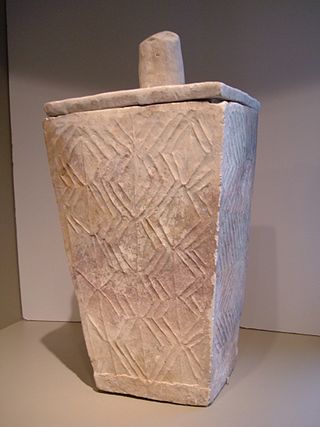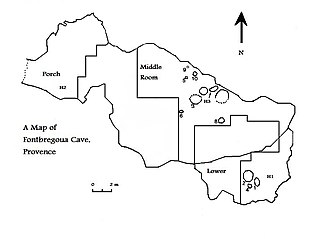Related Research Articles

A cave or cavern is a natural void in the ground, specifically a space large enough for a human to enter. Caves often form by the weathering of rock and often extend deep underground. The word cave can refer to smaller openings such as sea caves, rock shelters, and grottos, that extend a relatively short distance into the rock and they are called exogene caves. Caves which extend further underground than the opening is wide are called endogene caves.

Kalaeloa is a census-designated place (CDP) in Honolulu County, Hawaii, United States. The population was 2,364 at the 2020 census. The community occupies the location of the former Naval Air Station Barbers Point, which was closed in 1999 and subsequently transferred to the State of Hawaiʻi. The geographical name, Ka lae loa, means "long point" in Hawaiian and is the native name for what has been called Barbers Point on Oʻahu. The area was known as Barbers Point because Captain Henry Barber wrecked his ship on a coral shoal at this location on October 31, 1796.

Burial, also known as interment or inhumation, is a method of final disposition whereby a dead body is placed into the ground, sometimes with objects. This is usually accomplished by excavating a pit or trench, placing the deceased and objects in it, and covering it over. A funeral is a ceremony that accompanies the final disposition. Evidence suggests that some archaic and early modern humans buried their dead. Burial is often seen as indicating respect for the dead. It has been used to prevent the odor of decay, to give family members closure and prevent them from witnessing the decomposition of their loved ones, and in many cultures it has been seen as a necessary step for the deceased to enter the afterlife or to give back to the cycle of life.

Shanidar Cave is an archaeological site on Bradost Mountain, within the Zagros Mountains in the Erbil Governorate of Kurdistan Region in northern Iraq. Neanderthal remains were discovered here in 1953, including Shanidar 1, who survived several injuries, possibly due to care from others in his group, and Shanidar 4, the famed 'flower burial'. Until this discovery, Cro-Magnons, the earliest known H. sapiens in Europe, were the only individuals known for purposeful, ritualistic burials.

A morgue or mortuary is a place used for the storage of human corpses awaiting identification (ID), removal for autopsy, respectful burial, cremation or other methods of disposal. In modern times, corpses have customarily been refrigerated to delay decomposition.

In archaeology and anthropology, the term excarnation refers to the practice of removing the flesh and organs of the dead before burial. Excarnation may be achieved through natural means, such as leaving a dead body exposed to the elements or for animals to scavenge; or by butchering the corpse by hand. Following excarnation, some societies retrieved the excarnated bones for burial. Excarnation has been practiced throughout the world for hundreds of thousands of years. The earliest archaeological evidence of excarnation is from the Awash River Valley in Ethiopia, 160,000 years ago. Examples of excarnation include "sky burials" in parts of Asia, the Zoroastrian "Tower of Silence", and Native American "tree burials". Excarnation is practiced for a variety of spiritual and practical reasons, including the Tibetian spiritual belief that excarnation is the most generous form of burial and the Comanche practical concern that in the winter the ground is too hard for an underground burial. Excarnation sites are identifiable in the archaeological record by a concentration of smaller bones, which would be the bones that would be the easiest to fall off the body, and that would not be noticed by practitioners of excarnation.

A cenote is a natural pit, or sinkhole, resulting when a collapse of limestone bedrock exposes groundwater. The term originated on the Yucatán Peninsula of Mexico, where the ancient Maya commonly used cenotes for water supplies, and occasionally for sacrificial offerings. The name derives from a word used by the lowland Yucatec Maya—tsʼonoʼot—to refer to any location with accessible groundwater.

The Adena culture was a Pre-Columbian Native American culture that existed from 500 BCE to 100 CE, in a time known as the Early Woodland period. The Adena culture refers to what were probably a number of related Native American societies sharing a burial complex and ceremonial system. The Adena culture was centered on the location of the modern state of Ohio, but also extended into contiguous areas of northern Kentucky, eastern Indiana, West Virginia, and parts of extreme western Pennsylvania.

The Great Blue Hole is a giant marine sinkhole off the coast of Belize. It lies near the center of Lighthouse Reef, a small atoll 70 km (43 mi) from the mainland and Belize City. The hole is circular in shape, 318 m (1,043 ft) across and 124 m (407 ft) deep. It has a surface area of 70,650 square metres (760,500 sq ft). It was formed during several phases of the Quaternary glaciation when sea levels were much lower. Analysis of stalactites found in the Great Blue Hole shows that formation took place 153,000, 66,000, 60,000, and 15,000 years ago. As the ocean began to rise again, the cave was flooded. The Great Blue Hole is a part of the larger Belize Barrier Reef Reserve System, a UNESCO World Heritage Site.

The Xagħra Stone Circle, also known as the Xagħra Hypogeum or the Brochtorff Circle, is a Neolithic funerary complex located in Xagħra, Gozo, Malta. It consists of a series of caves which were used to bury the dead, and which were surrounded by a walled enclosure. It mainly dates back to around 3000 to 2400 BC, although the earliest tombs at the site date back to 4100 to 3800 BC. The caves collapsed sometime before 2000 BC, and the site was later used for domestic and agricultural purposes.

Natural burial is the interment of the body of a dead person in the soil in a manner that does not inhibit decomposition but allows the body to be naturally recycled. It is an alternative to typical contemporary Western burial methods and modern funerary customs.

The Cave Without a Name is a limestone solutional cave in the Texas Hill Country region of Central Texas. It is a National Natural Landmark.

Alkaline hydrolysis is a process for the disposal of human and pet remains using lye and heat, and is an alternative to burial or cremation.

The Makauwahi Cave is the largest limestone cave found in Hawaii. It lies on the south coast of the island of Kauaʻi, in the Māhāʻulepū Valley close to Māhāʻulepū Beach, and is important for its paleoecological and archaeological values. It is reached via a sinkhole and has been described as “…maybe the richest fossil site in the Hawaiian Islands, perhaps in the entire Pacific Island region”.

Cueva de la Candelaria is an archaeological site located the Mexican state of Coahuila. It is a cave that was used as cemetery by nomad visitors. Early site research was made in 1953 and there was a later season in 1954. As a result of these investigations, many materials were recovered and are kept by Instituto Nacional de Antropología e Historia (INAH).

Jar burial is a human burial custom where the corpse is placed into a large earthenware container and then interred. Jar burials are a repeated pattern at a site or within an archaeological culture. When an anomalous burial is found in which a corpse or cremated remains have been interred, it is not considered a "jar burial".

Devil's Sinkhole State Natural Area is a natural bat habitat near the city of Rocksprings in Edwards County in the U.S. state of Texas. Carved by water erosion, the cavern is home to several million Mexican free-tailed bats that emerge at sunset during April through October.

Fontbrégoua Cave is an archaeological site located in Provence, Southeastern France. It was used by humans in the fifth and fourth millennia BCE, in what is now known as the Early and Middle Neolithic. A temporary residential site, it was used by Neolithic agriculturalists as a storage area for their herds of goats and sheep, and also contained a number of bone depositions, containing the remains of domestic species, wild animals, and humans. The inclusion of the latter of these deposits led the archaeological team studying the site to propose that cannibalism had taken place at Fontbrégoua, although other archaeologists have instead suggested that they represent evidence of secondary burial.
Bering Sinkhole is an early American archaeological site in Kerr County, Texas, United States. The mortuary sinkhole included human remains of 62 individuals, animal remains, and turtle-shell, marine-shell, antler and stone artefacts. Radiocarbon dating found that the earliest burials were from approximately 5000 years BC.
References
- ↑ Alvarez, Christine E. (May 2005). "Bioarchaeological Investigation of Human Skeletal Remains at the Stiver Ranch Burial Sinkhole (41KM140)".
{{cite journal}}: Cite journal requires|journal=(help) - ↑ Bement, Leland C. (1994). Hunter-Gatherer Mortuary Practices during the Central Texas Archaic. University of Texas Press. doi:10.7560/708174. ISBN 978-0-292-70817-4.
- ↑ "Burial Caves in Virginia". www.virginiaplaces.org. Retrieved 2023-08-02.
- ↑ "Kalaeloa Heritage Park ʻEwa, Oʻahu FINAL ENVIRONMENTAL ASSESSMENT" (PDF). hawaii.gov. September 2014.
- ↑ "Sinkhole on Bloody Hill (U.S. National Park Service)". www.nps.gov. Retrieved 2023-08-02.